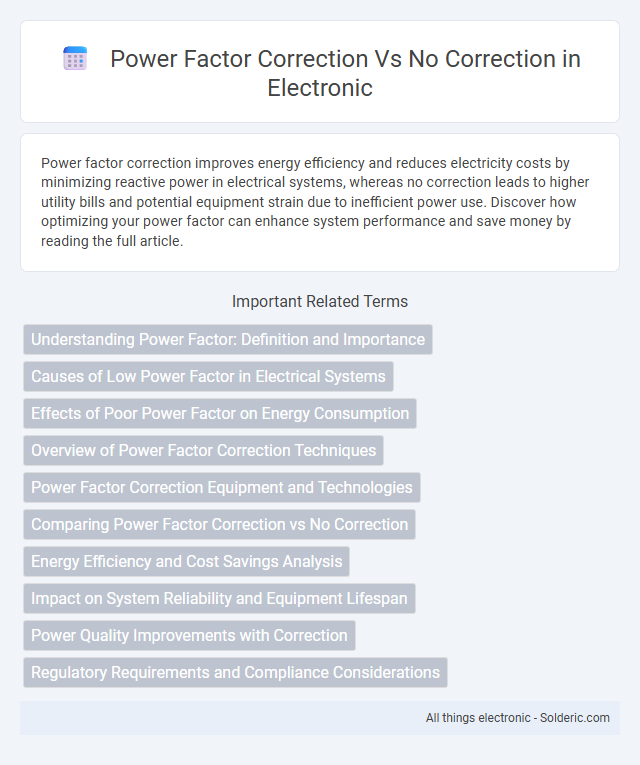Power factor correction improves energy efficiency and reduces electricity costs by minimizing reactive power in electrical systems, whereas no correction leads to higher utility bills and potential equipment strain due to inefficient power use. Discover how optimizing your power factor can enhance system performance and save money by reading the full article.
Comparison Table
| Aspect | Power Factor Correction (PFC) | No Power Factor Correction |
|---|---|---|
| Power Factor | Improved, close to unity (0.95 - 1.0) | Low, often between 0.5 - 0.8 |
| Energy Efficiency | Higher efficiency, reduced energy losses | Lower efficiency, increased losses |
| Electricity Costs | Reduced utility bills due to lower reactive power charges | Higher bills from penalties and wasted energy |
| System Stability | Improved voltage regulation and reduced overheating | Voltage drops, equipment overheating risk |
| Equipment Lifespan | Extended lifespan due to balanced loads | Reduced lifespan from increased stress |
| Environmental Impact | Lower carbon footprint through efficient energy use | Higher emissions due to wasted power |
Understanding Power Factor: Definition and Importance
Power factor measures the efficiency of electrical power usage, defined as the ratio of real power to apparent power in an AC electrical system. Low power factor indicates poor utilization of electrical power, leading to increased energy losses, higher utility bills, and potential penalties from power providers. Power factor correction improves system efficiency by aligning voltage and current phases, reducing reactive power, and enhancing overall energy consumption and equipment lifespan.
Causes of Low Power Factor in Electrical Systems
Low power factor in electrical systems primarily arises from inductive loads such as motors, transformers, and fluorescent lighting, which cause the current to lag behind the voltage. The presence of harmonics generated by non-linear loads, including variable frequency drives and electronic devices, further deteriorates the power factor. Without power factor correction, these conditions lead to increased reactive power, higher energy losses, and reduced system efficiency.
Effects of Poor Power Factor on Energy Consumption
Poor power factor increases energy consumption by causing higher current flow, leading to greater losses in electrical distribution systems and inflated utility bills for your facility. Without power factor correction, electrical equipment experiences increased heat generation and reduced lifespan due to inefficiencies. Implementing power factor correction optimizes energy use, lowers demand charges, and improves total system reliability.
Overview of Power Factor Correction Techniques
Power Factor Correction (PFC) techniques improve electrical efficiency by minimizing reactive power in AC systems, reducing energy losses and utility charges. Common PFC methods include passive correction using capacitors or inductors, active correction with power electronics to dynamically adjust power factor, and hybrid systems combining both approaches for optimal performance. Without PFC, electrical systems experience higher energy costs, increased heat generation, and reduced equipment lifespan due to poor power factor and increased demand charges.
Power Factor Correction Equipment and Technologies
Power factor correction equipment, such as capacitor banks, synchronous condensers, and active power factor correction devices, improves electrical efficiency by reducing reactive power and minimizing losses in power systems. Without power factor correction, increased reactive power causes higher demand charges, reduced system capacity, and elevated energy costs. Implementing advanced power factor correction technologies enhances voltage stability, decreases heat generation in electrical components, and extends the lifespan of electrical infrastructure.
Comparing Power Factor Correction vs No Correction
Power factor correction (PFC) improves electrical efficiency by reducing reactive power, leading to lower energy consumption and decreased utility charges compared to systems without correction. Without power factor correction, increased current flow causes higher losses in electrical infrastructure, reduced equipment lifespan, and potential penalties from utilities due to poor power factor values. Implementing PFC optimizes energy use, enhances voltage stability, and increases the capacity of electrical installations by minimizing wasted power and improving overall system performance.
Energy Efficiency and Cost Savings Analysis
Power factor correction significantly improves energy efficiency by reducing reactive power, minimizing losses in electrical systems and lowering electricity consumption. Without power factor correction, utilities often charge higher demand fees due to poor power factor, leading to increased operational costs. Implementing power factor correction devices results in substantial cost savings by optimizing electrical load, decreasing energy bills, and extending equipment lifespan.
Impact on System Reliability and Equipment Lifespan
Power factor correction improves system reliability by reducing reactive power, minimizing voltage drops, and enhancing voltage stability, which leads to fewer equipment malfunctions and downtime. Without power factor correction, electrical systems experience higher currents and increased heat generation, accelerating wear and reducing the lifespan of transformers, motors, and other critical components. Optimized power factor not only lowers energy losses but also extends equipment durability, resulting in more consistent performance and reduced maintenance costs over time.
Power Quality Improvements with Correction
Power factor correction significantly enhances power quality by reducing harmonic distortion, voltage drops, and reactive power losses in electrical systems. Improved power factor leads to more efficient energy use, stabilizing voltage levels and minimizing equipment overheating and premature failures. Without correction, poor power factor causes increased energy costs, higher carbon emissions, and reduced lifespan of electrical components due to inefficient power delivery.
Regulatory Requirements and Compliance Considerations
Power factor correction is essential to meet regulatory requirements set by energy authorities worldwide, as inefficient power factor often leads to penalties and increased utility charges. Without correction, facilities risk non-compliance with standards such as IEEE 519 and EN 61000-3-2, which govern harmonic distortion and power quality. Implementing power factor correction ensures adherence to these regulations, reduces demand charges, and improves overall electrical system efficiency.
Power Factor Correction vs No Correction Infographic

 solderic.com
solderic.com